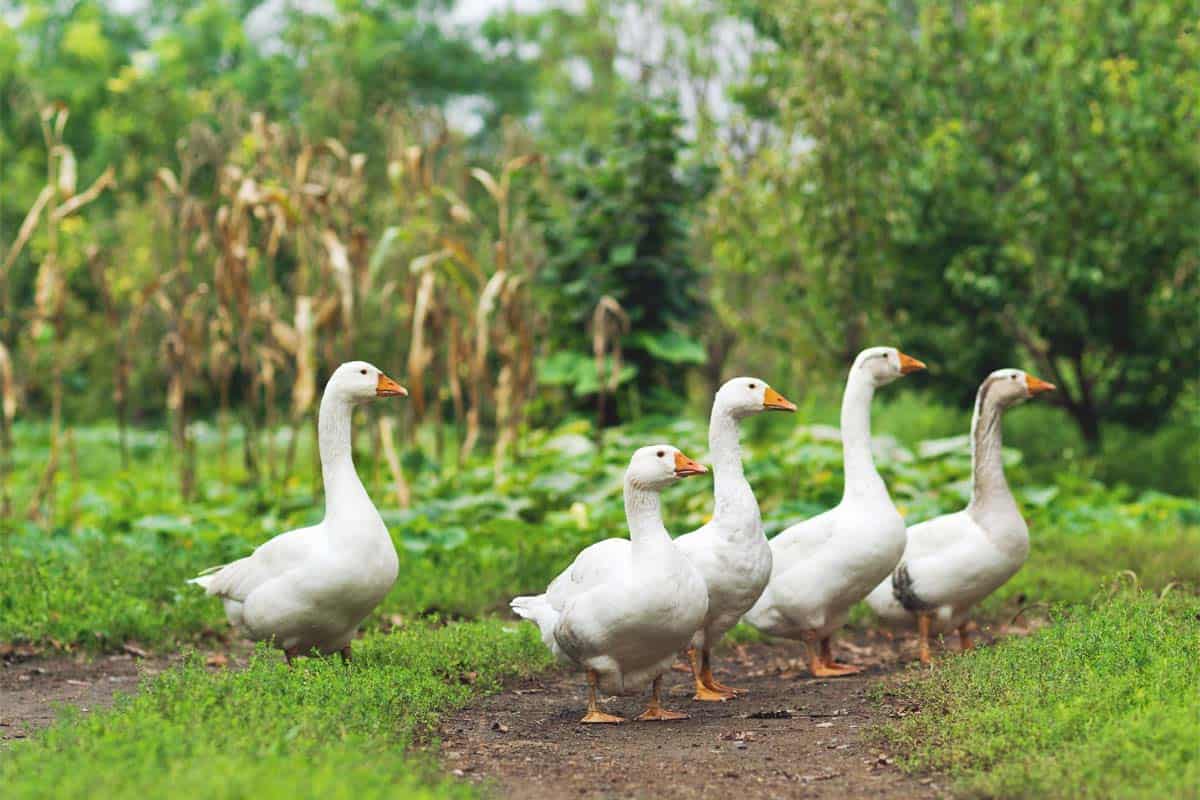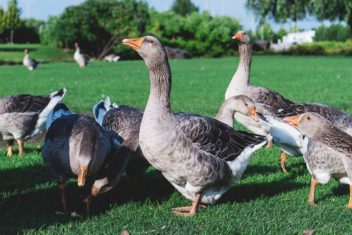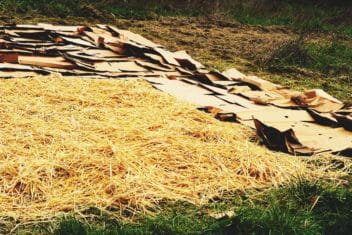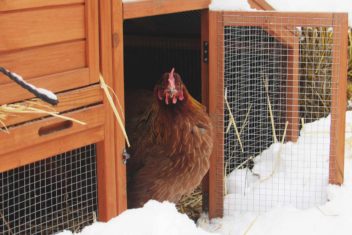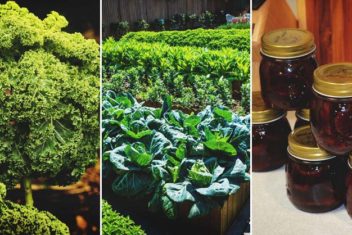An entertaining and productive addition to any backyard flock, the goose is commonly avoided by livestock beginners – and for no good reason.
Many people (myself, at one time, included) believe that geese are mean, aggressive, and frankly, not that helpful on a small farm.
That’s far from the case. Geese are not only friendly in most cases, but also good at providing meat, eggs, and other services. Some people even raise geese as pets.
If you’re thinking about raising any geese breed, and there are many reasons why you should, below are our top reasons. We’ll also share a list of eight most popular geese breeds to consider.
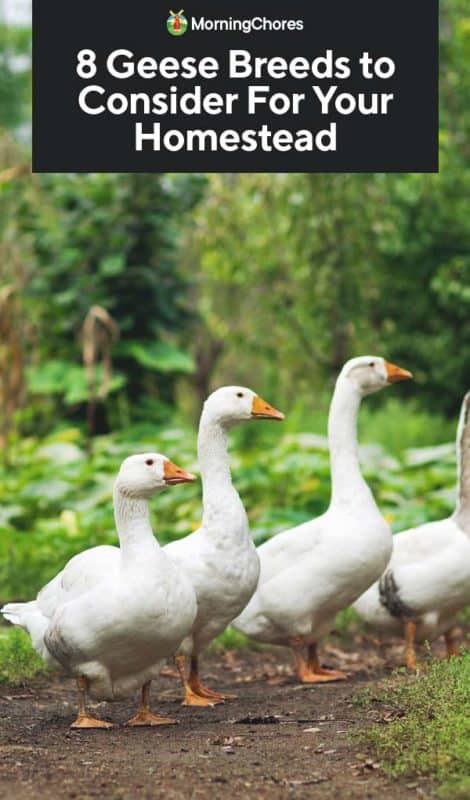
Why You Should Consider Raising Geese
Raising geese provides a ton of benefits to you as a farmer. Not only can geese be raised for both meat and eggs, but they are also excellent guardian animals. Some people raise geese with other livestock (like chickens) to keep the smaller species from being attacked by small predators like hawks and weasels.
But did you know that geese have some less-common uses as well? Some people use their flock of geese to keep the areas around their vineyards, orchards, or other delicate areas free from weeds. Known as “weeder geese,” these creatures are the perfect animals for the job.
8 Best Geese Breeds to Consider
1. African Geese
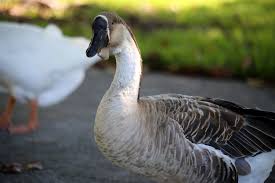
– History
Despite the contradictory nature of the name, African geese likely did not originate in Africa, but instead in China or somewhere else in Asia.
These birds are characterized by prominent black knobs that sit at the top of their beaks (although some color variations of the breed have orange knobs). They are heavy-bodied geese with full abdomens and large dewlaps. An upright, loud goose, with a tendency to be aggressive.
– Weight
African ganders tend to weigh about 20 lbs each. While ganders can reach 22 lbs, females are likely to be much smaller (about 18 lbs).
– Uses
More often than not, African geese are kept for meat. Since they are so large, they produce a decent weight at dressing and have a remarkable flavor. Geese of this breed can also be raised for eggs.
While some owners report that they are not reliable layers, others argue that they are. Some individuals can produce up to 30-50 eggs each year!
They are also exceptional foragers.
These birds are closely related to Chinese geese and have a similar appearance. However, African geese are susceptible to frostbite and require insulated shelter during cold weather.
2. Embden Geese
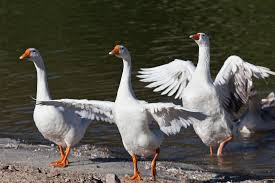
– History
Embden geese are large and white, with prominent orange bills and feet. A heavyweight goose, it is believed to have originated in Germany in the 1800s. Designed primarily for meat, this goose was popular in some of the first American settlements where versatility and ease of care were duly prized.
– Weight
Male Embdens can reach more than 28 lbs, often topping out at 31 lbs or more. Females are usually smaller, around 20 lbs.
– Uses
The Embden goose breed is primarily a meat bird. It is also quieter than other types of geese, making it a good choice as a pet or guardian on a hobby farm. An increasingly popular bird, the Embden is one of the largest you will find and is quick-growing making it a good choice for a meat operation. However, it can also lay about thirty to forty eggs each year.
3. Roman Tufted

– History
Often considered an ancient breed, the Roman Tufted goose is one of the smallest out of all of those on our list. It was once used to guard the ancient temples of Rome. Legend has it that Roman Tufted Geese were even able to stop an attempted Gaul ambush in 365 BC! Pretty impressive.
Today, however, this breed is mostly used to guard backyard flocks of chicken as well as other types of property. It can also be raised for meat and eggs.
– Weight
Roman Tufted Geese, with their elegant white plumage and top-hat tufts of white feathers, only weigh about ten pounds when they are fully mature.
– Uses
Unfortunately, Roman Tufted geese are listed as critically endangered. Therefore, they are difficult to find on American farms. However, if you manage to find one, you’ll have great success – these birds are excellent egg layers. Although they are small as meat birds, their loud voices make them superb guards.
Their bark is definitely bigger than their bite, though, as these geese tend to be quite docile.
Roman Tufted ganders can be a bit aggressive, so keep an eye out for those behaviors.
4. Toulouse
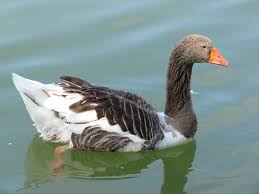
– History
The classic French goose, Toulouse has a lightweight and heavyweight form. The heavyweight Toulouse, known as the Dewlap Toulouse, is the largest breed of domesticated geese. The smaller Toulouse, the French Toulouse, is much smaller.
– Weight
Even when the two variations of this breed are compared, Toulouse geese in general are some of the largest. Both are a plain gray in color, but the Dewlap Toulouse has a large dewlap beneath its bill along with a dense abdomen and keel. Dewlap Toulouse easily grow into 20 or 30 lbs when mature. French Toulouse are somewhat smaller and thinner, but still reach impressive weights.
– Uses
Both Toulouse varieties can be used for meat and eggs. The Dewlap Toulouse was developed particularly for the production of foie gras, while French Toulouse were developed as dual-purpose birds. They produce large white eggs during the spring and summer seasons. Both Dewlap and French Toulouse geese are known for being docile and calm, so they can also serve as farm pets.
5. Sebastopol

– History
One of the most distinctive goose breeds, Sebastopol is easy to identify with its white plumage of unkempt feathers. It looks like it’s been through a war! Nevertheless, this goose is often raised for show, originally bred in eastern Europe for this purpose. This breed was popular in the 20th century but has since fallen from favor ever so slightly.
– Weight
Gander Sebastopols generally weigh about 12-14 lbs, while females weigh just 10-12 lbs.
– Uses
Sebastopol geese do need some targeted care when it comes to keeping them happy all year-round. These birds need warm shelter for the winter months as well as lots of clean water to swim in. Otherwise, these birds are quite loud and boisterous. There are several crosses of this breed, too, including buff, gray, and saddle back variants.
Sebastopols are usually raised as guardians, but they can also be raised for eggs and meat. They produce about 25 to 35 eggs each year.
6. Chinese
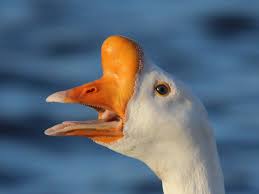
– History
The Chinese goose breed is not one to mess with! Perfect as a weeder or guardian goose, this species has a unique appearance. Like the African goose, the Chinese goose has a prominent knob on its bill – a feature more prominent on males than on females. The bird is small and upright.
– Weight
The Chinese goose generally only weighs about ten pounds, but males can weigh as much as 12 lbs.
– Uses
The Chinese goose breed is one of the loudest. They have shrill, piercing voices that can quickly alienate you from your neighbors – urban farmers, this breed is not for you. However, that’s part of what makes this breed so useful. If any predator attacks your farm or any intruder dares to step foot on your doorstep, this goose is sure to sound the alarm. They are also good at keeping a field closely trimmed.
Chinese geese are also some of the best egg layers – they can produce up to 100 eggs each year!
7. Buff
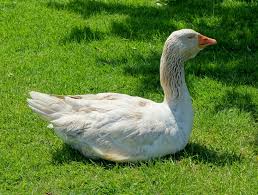
– History
The American Buff developed from a breed of a similar nature in the United Kingdom. With a bizarre apricot-colored plumage, this breed is highly versatile. It can be raised for eggs, meat, or even for other purposes, like weeding.
– Weight
American Buff geese are medium-weight birds, weighing about 16-18 pounds on average.
– Uses
Buff geese are quite friendly, fitting in well on a family farm. They are easily adaptable and can be used for both meat and eggs. Their gorgeous coloring also serves them well as farm pets. As a backyard favorite, Buff geese are good weeder geese and also quite eye-catching.
8. Pilgrim

– History
The Pilgrim goose is highly unique. Although it looks much like other breeds on this list, it has one distinct difference – it is one of the few varieties of geese that can be autosexed. Each gender is a different color, with differences apparent at hatching. While adult females are gray, males are white with orange bills.
Developed by Oscar Grow in Iowa, this goose breed dates back to the 1900s. The name “Pilgrim” refers to Grow’s family’s “pilgrimage” to Missouri from Iowa in the midst of the Great Depression.
– Weight
Pilgrim geese are not behemoths by any means, but they are still relatively large. Most weigh around 13 to 14 pounds at maturity. The bodies of this goose are plump and full with a smooth, keel-less breast.
– Uses
Pilgrim geese are highly versatile. They are medium weight birds and can also be used for egg production – they’ll give you about forty every year. They are also good at foraging and can be used with great success for weeding. Quiet, calm birds, Pilgrim geese are unusually friendly.
Other Goose Breeds to Consider
While these eight goose breeds are arguably the most popular – and the most common on small farms – the list of breeds to consider does not end there.
Geese breeds are generally broken down into three categories based on their weight: heavy, medium, and light. Other options for you to consider include Alsatian, Barnacle, Faroese, and Pomeranian – but there are dozens of other alternatives out there, too.
No matter what kind of goose breed you choose to raise, know that the benefits are impressive. Geese are delightful creatures to have on your homestead, no matter what you decide to raise them for.
